ISUZU NKR, NPR, NQR Service Manual

WORKSHOP MANUAL
NKR . NPR . NQR
ANTI-LOCK BRAKE SYSTEM (ABS)
SECTION 5A4

HOME
ANTI-LOCK BRAKE SYSTEM (ABS) 5A4-1
SECTION 5A4
ANTI-LOCK BRAKE SYSTEM (ABS)
Service Precaution
CAUTION: Always use the correct fastener in the proper location. When you replace a fastener, use ONLY the exact part number for that application. ISUZU will call out those fasteners that require a replacement after removal. ISUZU will also call out the fasteners that require thread lockers or thread sealant. UNLESS OTHERWISE SPECIFIED, do not use supplemental coatings (Paints, greases, or other corrosion inhibitors) on threaded fasteners or fastener joint interfaces. Generally, such coatings adversely affect the fastener torque and the joint clamping force, and may damage the fastener. When you install fasteners, use the correct tightening sequence and specifications. Following these instructions can help you avoid damage to parts and systems.
CONTENTS
|
PAGE |
|
Service Precaution .......................................................................................................... |
5A4 |
-1 |
General Description ........................................................................................................ |
5A4 |
-5 |
System Components .................................................................................................. |
5A4 |
-6 |
Electronic Hydraulic Control Unit (EHCU) ................................................................ |
5A4 |
-6 |
Hydraulic Unit (HU) ..................................................................................................... |
5A4 |
-6 |
ABS Warning Light ..................................................................................................... |
5A4 |
-6 |
Wheel Speed Sensor .................................................................................................. |
5A4 |
-6 |
Normal and Anti-lock Braking.................................................................................... |
5A4 |
-6 |
Brake Pedal Travel...................................................................................................... |
5A4 |
-7 |
Acronyms and Abbreviations .................................................................................... |
5A4 |
-7 |
General Diagnosis ........................................................................................................... |
5A4 |
-7 |
General Information.................................................................................................... |
5A4 |
-7 |
ABS Service Precautions ........................................................................................... |
5A4 |
-7 |
Computer System Service Precautions .................................................................... |
5A4 |
-7 |
General Service Precautions ..................................................................................... |
5A4 |
-8 |
Note on Intermittents.................................................................................................. |
5A4 |
-8 |
Test Driving ABS Complaint Vehicles....................................................................... |
5A4 |
-8 |
“ABS” Warning Light.................................................................................................. |
5A4 |
-8 |
Normal Operation ....................................................................................................... |
5A4 |
-8 |
Basic Diagnostic Flow Chart ..................................................................................... |
5A4 |
-9 |
Basic Inspection Procedure....................................................................................... |
5A4 |
-9 |

5A4-2 ANTI-LOCK BRAKE SYSTEM (ABS)
Tech 2 Scan Tool ........................................................................................................ |
5A4 -10 |
Tech 2 Features .......................................................................................................... |
5A4 -11 |
Getting Started ............................................................................................................ |
5A4 -11 |
Operating Procedure (For Example) ......................................................................... |
5A4 -12 |
DTC Modes .................................................................................................................. |
5A4 -13 |
DTC Information Mode ............................................................................................... |
5A4 -13 |
Plotting Snapshot Graph............................................................................................ |
5A4 -14 |
Plotting Graph Flow Chart (Plotting graph after obtaining vehicle information) .. |
5A4 -15 |
Flow Chart for Snapshot Replay (Plotting Graph) ................................................... |
5A4 -16 |
Tech 2 Data Display .................................................................................................... |
5A4 -17 |
Special Function ......................................................................................................... |
5A4 -17 |
EHCU Connector Pin-out Checks.............................................................................. |
5A4 -21 |
Circuit Diagram ........................................................................................................... |
5A4 -22 |
Connector List ............................................................................................................ |
5A4 -26 |
Part Location ............................................................................................................... |
5A4 -29 |
Symptom Diagnosis ........................................................................................................ |
5A4 -30 |
Chart A-1 ABS Works Frequently But Vehicle Does Not Decelerate...................... |
5A4 -30 |
Chart TA-1 ABS Works Frequently But Vehicle |
|
Does Not Decelerate (Use TECH 2) ........................................................................... |
5A4 -30 |
Chart A-2 Uneven Braking Occurs While ABS Works ............................................. |
5A4 -31 |
Chart A-3, TA-3 The Wheels Are Locked................................................................... |
5A4 -31 |
Chart A-4 Brake Pedal Feed Is Abnormal ................................................................. |
5A4 -32 |
Chart A-5, TA-5 Braking Sound (From Hydraulic Unit) |
|
Is Heard While Not Braking........................................................................................ |
5A4 -33 |
Diagnostic Trouble Codes .............................................................................................. |
5A4 -34 |
Diagnosis By “ABS” Warning Light Illumination Pattern ............................................ |
5A4 -35 |
Diagnostic Trouble Codes (DTCs)............................................................................. |
5A4 -35 |
Chart B-1-1 With the key in the ON position (Before starting the engine). |
|
Warning light (W/L) is not activated. ......................................................................... |
5A4 -39 |
Chart 1 (DTC 13/C0213) Vehicle Type Error.............................................................. |
5A4 -40 |
Chart 2 (DTC 14/C0214) Low Power Voltage of |
|
Rear Sensor or EHCU Abnormality ........................................................................... |
5A4 -40 |
Chart 3 (DTC 15/C0215) Low Power Voltage OUT of Range ................................... |
5A4 -41 |
Chart 4 (DTC 25/C0225) Exhaust Brake Cut Circuit Abnormality ........................... |
5A4 -42 |
Chart 5 (DTC 33/C0233) Motor Drive Circuit Abnormality ....................................... |
5A4 -42 |

ANTI-LOCK BRAKE SYSTEM (ABS) 5A4-3
Chart 6 (DTC 34/C0234) Abnormal Motor Rotation .................................................. |
5A4 -42 |
Chart 7 (DTC 41/C0241) Solenoid Valve Power Supply Abnormality ..................... |
5A4 -43 |
Chart 8 (DTC 43, 45/C0243, C0245) Solenoid Valve Circuit Abnormality ............... |
5A4 -43 |
Chart 9 (DTC 51/C0251) FL Speed Sensor Circuit Abnormality .............................. |
5A4 -43 |
Chart 10 (DTC 52/C0252) FR Speed Sensor Circuit Abnormality............................ |
5A4 -43 |
Chart 11 (DTC 53/C0253) RL Speed Sensor Circuit Abnormality............................ |
5A4 -44 |
Chart 12 (DTC 54/C0254) RR Speed Sensor Circuit Abnormality ........................... |
5A4 -45 |
Chart 13 (DTC 61/C0261) Abnormal FL Speed Sensor Signal................................. |
5A4 -46 |
Chart 14 (DTC 62/C0262) Abnormal FR Speed Sensor Signal ................................ |
5A4 -48 |
Chart 15 (DTC 63/C0263) Abnormal RL Speed Sensor Signal ................................ |
5A450 |
Chart 16 (DTC 64/C0264) Abnormal RR Speed Sensor Signal................................ |
5A451 |
Chart 17 (DTC 65/C0265) Tire Size Error................................................................... |
5A452 |
Unit Inspection Procedure.............................................................................................. |
5A453 |
Chart C-1-1 FL Speed Sensor Output Inspection Procedure .................................. |
5A453 |
Chart C-1-2 FR Speed Sensor Output Inspection Procedure.................................. |
5A454 |
Chart C-1-3 RL Speed Sensor Output Inspection Procedure.................................. |
5A455 |
Chart C-1-4 RR Speed Sensor Output Inspection Procedure ................................. |
5A457 |
Chart TC-1 Sensor Output Inspection Procedure (Use TECH 2) ............................ |
5A458 |
Electronic Hydraulic Control Unit (EHCU)..................................................................... |
5A459 |
Removal....................................................................................................................... |
5A459 |
Installation................................................................................................................... |
5A459 |
Front Speed Sensor ........................................................................................................ |
5A460 |
Front Speed Sensor and Associated Parts .............................................................. |
5A460 |
Removal....................................................................................................................... |
5A460 |
Inspection and Repair ................................................................................................ |
5A460 |
Installation................................................................................................................... |
5A460 |
Front Speed Sensor Rotor.............................................................................................. |
5A461 |
Front Speed Sensor Rotor and Associated Parts .................................................... |
5A461 |
Removal....................................................................................................................... |
5A461 |
Inspection and Repair ................................................................................................ |
5A462 |
Installation................................................................................................................... |
5A462 |
Rear Speed Sensor ......................................................................................................... |
5A463 |
Rear Speed Sensor and Associated Parts................................................................ |
5A463 |
Removal....................................................................................................................... |
5A464 |
Inspection and Repair ................................................................................................ |
5A464 |

5A4-4 ANTI-LOCK BRAKE SYSTEM (ABS)
Installation................................................................................................................... |
5A464 |
Rear Speed Sensor Rotor ............................................................................................... |
5A465 |
Rear Speed Sensor Rotor and Associated Parts ..................................................... |
5A465 |
Removal....................................................................................................................... |
5A465 |
Inspection and Repair ................................................................................................ |
5A465 |
Installation................................................................................................................... |
5A465 |
Special Tools ................................................................................................................... |
5A467 |
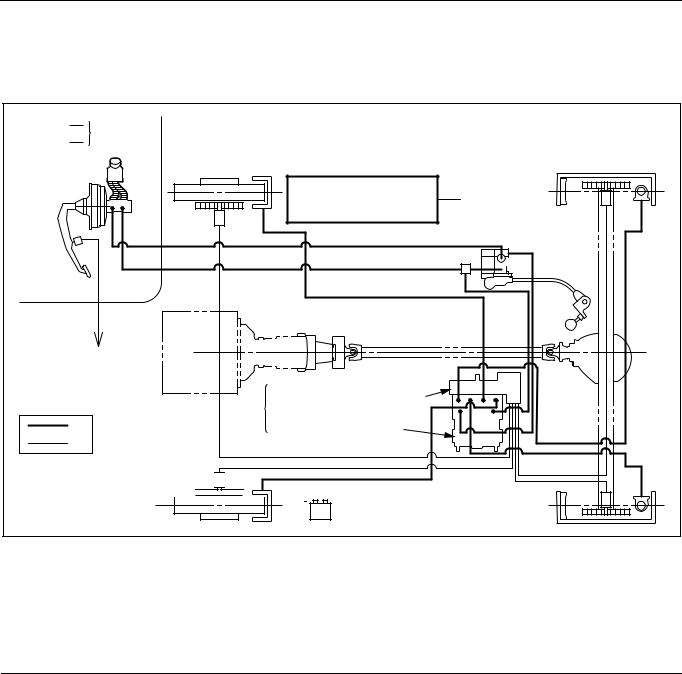
ANTI-LOCK BRAKE SYSTEM (ABS) 5A4-5
General Description
The Anti-lock Brake System (ABS) works on all four wheels. A combination of wheel speed sensor and Electronic Hydraulic Control Unit (EHCU) can
determine when a wheel is about to stop turning and adjust brake pressure to maintain best braking.
This system helps the drive maintain greater control of the vehicle under heavy braking conditions.
9 |
ABS |
TO EHCU |
|||
|
|
||||
6 |
DIAG |
||||
|
|
|
|||
|
|
|
|
|
|
|
|
|
|
|
|
CAB |
4 |
|
|
|
10 |
ENGINE CONTROLLER |
|
|
OR |
TO EHCU |
5 |
EXH BRAKE CUT RELAY |
|
|

 7
7
TO EHCU |
|
3 |
ELECTRONIC HYDRAULIC |
EHCU |
CONTROL UNIT(EHCU) |
1 |
HYDRAULIC UNIT(HU) |
2 |
|
4 


 5
5
8
Legend |
|
|
|
(1) |
Hydraulic Line |
(7) |
Load Sensing Proportioning Valve (LSPV) |
(2) |
Electronic Line |
(8) |
Battery |
(3) |
Electronic Hydraulic Control Unit (EHCU) |
(9) |
ABS Warning Light |
(4) |
Front Wheel Speed Sensor |
(10) |
Brake Switch |
(5)Rear Wheel Speed Sensor
(6)Diagnosis Connector
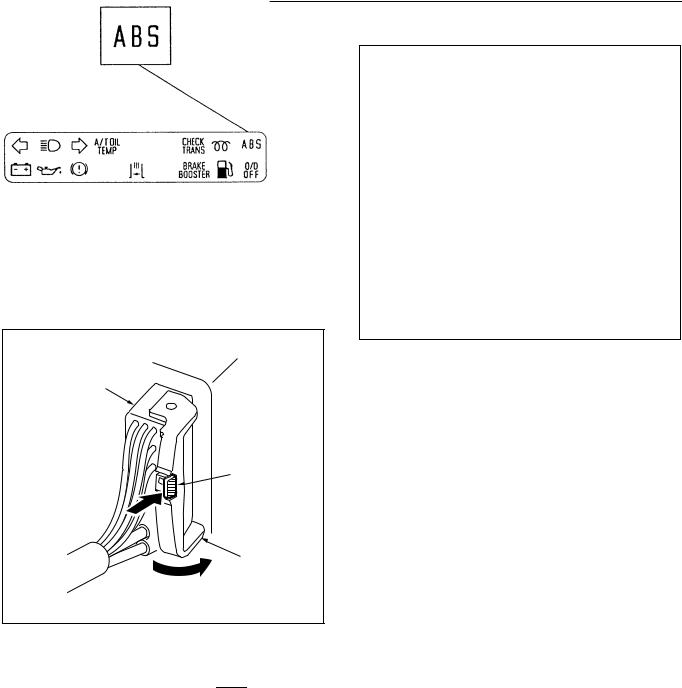
5A4-6 ANTI-LOCK BRAKE SYSTEM (ABS)
System Components |
ABS Warning Light |
The Anti-lock Brake System consists of a Electronic
Hydraulic Control Unit (EHCU), four Wheel Speed
Sensors and Warning Light.
Electronic Hydraulic Control Unit (EHCU)
The EHCU consists of Electronic Brake Control Module (EBCM) and Hydraulic Unit (HU).
The EHCU is located at the frame side, in front of rear spring bracket.
The EHCU consists of ABS control circuits, fault detector, and a fail-safe. It drives the hydraulic unit according to the signal from each sensor, cancelling ABS to return to normal braking when a malfunction has occurred in the ABS.
The EHCU is self-diagnosing function which can indicate faulty circuits during diagnosis.
CONNECTOR
EHCU
Tang lock
Push 
Lever
Move lever outside
NOTE:
When disconnecting harness connector from EHCU, push the tang lock of the connector (
 portion) and release the tang lock. Then move the lever.
portion) and release the tang lock. Then move the lever.
Hydraulic Unit (HU)
It consists of a Motor, Plunger Pump, Solenoid Valves and Check Valve.
Solenoid Valves: Reduces or holds the caliper fluid pressure for each front disc brake or both rear drum brakes according to the signal sent from the EHCU. Reservoir: Temporarily holds the brake fluid that returns from the front and rear wheel brake so that pressure of front wheel brake can be reduced smoothly.
Plunger Pump: Feeds the brake fluid held in the reservoir to the master cylinder.
Motor: Drives the pump according to the signal from EHCU. Check Valve: Controls the brake fluid flow.
Vehicles equipped with the Anti-lock Brake System has an amber “ABS” warning light in the instrument panel. The “ABS” warning light will illuminate if a malfunction in the Anti-lock Brake System is detected by the Electronic Hydraulic Control Unit (EHCU). In case of an electronic malfunction, the EHCU will turn
“ON” the “ABS” warning light and disable the Anti-lock braking function.
The “ABS” light will turn “ON” for 2 seconds after the ignition switch is to the “ON” position, and then will go out.
If the “ABS” light comes “ON” and stays “ON” while driving, the Anti-lock Brake System should be inspected for a malfunction according to the diagnosis procedure.
Wheel Speed Sensor
It consists of a sensor and a rotor. The sensor is attached to the knuckle on the front wheels and to the bracket on the brake back plate on the rear wheels. The front speed sensor is coil type and rear is Hall IC type.
The sensor rotors press-fitted to front and rear wheel hubs output pulse frequency depending on wheel rotation.
The speed sensors find vehicle speed from its frequency.
Normal and Anti-lock Braking
Under normal driving conditions, the Anti-lock Brake System functions the same as a standard power assisted brake system. However, with the detection of wheel lock-up, a slight bump or kick-back will be felt in the brake pedal. This pedal “bump” will be followed by a series of short pedal pulsations which occurs in rapid succession. The brake pedal pulsation will continue

ANTI-LOCK BRAKE SYSTEM (ABS) 5A4-7
until there is no longer a need for the anti-lock function or until the vehicle is stopped. A slight ticking or popping noise may be heard during brake applications when the Anti-lock features is being used.
When the Anti-lock feature is being used, the brake pedal may rise even as the brakes are being applied. This is also normal. Maintaining a consist force on the pedal will provide the shortest stopping distance.
Brake Pedal Travel
Vehicles equipped with the Anti-lock Brake System may be stopped by applying normal force to the brake pedal. Although there is no need to push the pedal beyond the point where it stops or holds the vehicle, by applying more force the pedal will continue to travel toward the floor.
This extra brake pedal travel is normal.
Acronyms and Abbreviations
Several acronyms and abbreviations are commonly used throughout this section:
ABS
Anti-lock Brake System
CKT
Circuit
DLC
Data Link Connector
DTC
Diagnostic Trouble Code
DVM
Digital Volt Meter (High Impedance Multimeter)
EHCU
Electronic Hydraulic Control Unit
FL
Front Left
FR
Front Right
GEN
Generator
HU
Hydraulic Unit
MV
Millivolts
RL
Rear Left
RR
Rear Right
RPS
Revolution per Second
SW
Switch
VDC
Volts DC
VAC
Volts AC
W/L
Warning Light
WSS
Wheel Speed Sensor
General Diagnosis
General Information
ABS malfunction can be classified into two types, those which can be detected by the ABS warning light and those which can be detected as a vehicle abnormality by the driver.
In either case, locate the fault in accordance with the “BASIC DIAGNOSTIC FLOWCHART” and repair. Please refer to Section 5A for the diagnosis of mechanical troubles such as brake noise, brake judder (brake pedal or vehicle vibration felt when braking), uneven braking, and parking brake trouble.
ABS Service Precautions
Required Tools and Items:
•Box Wrench
•Brake Fluid
•Special Tool
Some diagnosis procedures in this section require the installation of a special tool.
5-8840-0285-0 (J-39200) High Impedance Multimeter
When circuit measurements are requested, use a circuit tester with high impedance.
Computer System Service Precautions
The Anti-lock Brake System interfaces directly with the Electronic Hydraulic Control Unit (EHCU) which is a control computer that is similar in some regards to the Engine Control Module. These modules are designed to withstand normal current draws associated with vehicle operation. However, care must be taken to avoid overloading any of the EHCU circuits. In testing for opens or shorts, do not ground or apply voltage to any of the circuits unless instructed to do so by the appropriate diagnostic procedure. These circuits should only be tested with a high impedance multimeter 5-8840-0285-0 (J-39200) or special tools as described in this section. Power should never be removed or applied to any control module with the ignition in the “ON” position. Before removing or connecting battery cables, fuses or connectors, always turn the ignition switch to the “OFF” position.

5A4-8 ANTI-LOCK BRAKE SYSTEM (ABS)
General Service Precautions |
case of such trouble as can be detected by the driver |
|
The following are general precautions which should be |
as a vehicle symptom, however, it is necessary to give |
|
a test drive following the test procedure mentioned |
||
observed when servicing and diagnosing the Anti-lock |
||
below, thereby reproducing the symptom for trouble |
||
Brake System and/or other vehicle systems. Failure to |
||
diagnosis on a symptom basis: |
||
observe these precautions may result in Anti-lock |
||
1. Start the engine and make sure that the “ABS” W/L |
||
Brake System damage. |
||
• If welding work is to be performed on the vehicle |
goes OFF. If the W/L remains ON, it means that |
|
the Diagnostic Trouble Code (DTC) is stored. |
||
using an electric arc welder, the EHCU connector |
||
Therefore, read the code and locate the fault. |
||
should be disconnected before the welding |
||
2. Start the vehicle and accelerate to about 30km/h |
||
operation begins. |
||
• The EHCU connector should never be connected |
(19 mph) or more. |
|
3. Slowly brake and stop the vehicle completely. |
||
or disconnected with the ignition “ON”. |
||
• The EHCU is not separately serviceable and must |
4. Then restart the vehicle and accelerate to about 40 |
|
be replaced as assemblies. Do not disassemble |
km/h (25 mph) or more. |
|
any component which is designated as non- |
5. Brake at a time so as to actuate the ABS and stop |
|
serviceable in this Section. |
the vehicle. |
|
• If only rear wheels are rotated using jacks or drum |
6. Be cautious of abnormality during the test. If the |
|
tester, the system will diagnose a speed sensor |
W/L is actuated while driving, read the DTC and |
|
malfunction and the “ABS” warning light will |
locate the fault. |
|
illuminate. But actually no trouble exists. After |
7. If the abnormality is not reproduced by the test, |
|
inspection stop the engine once and re-start it, then |
make best efforts to reproduce the situation |
|
make sure that the “ABS” warning light does not |
reported by the customer. |
|
illuminate. |
8. If the abnormality has been detected, repair in |
|
If the battery has been discharged |
||
accordance with the “SYMPTOM DIAGNOSIS”. |
||
The engine may stall if the battery has been |
NOTE: |
|
completely discharged and the engine is started via |
• Be sure to give a test drive on a wide, even road |
|
jumper cables. This is because the Anti-lock Brake |
||
with little traffic. |
||
System (ABS) requires a large quantity of electricity. In |
||
• If an abnormality is detected, be sure to suspend |
||
this case, wait until the battery is recharged, or set the |
||
the test and start trouble diagnosis at once. |
||
ABS to a non-operative state by removing the fuse for |
||
|
||
the ABS. After the battery has been recharged, stop |
“ABS” Warning Light |
|
the engine and install the ABS fuse. Start the engine |
||
When ABS trouble occurs and actuates when possible |
||
again, and confirm that the ABS warning light does not |
||
light. |
the “ABS” warning light, the trouble code |
|
|
corresponding to the trouble is stored in the EHCU. |
|
Note on Intermittents |
Only the ordinary brake system is available when the |
|
As with virtually any electronic system, it is difficult to |
ABS is turned OFF. When the “ABS” warning light is |
|
actuated, if the starter switch is set ON after setting it |
||
identify an intermittent failure. In such a case |
||
OFF once, the EHCU checks up on the entire system |
||
duplicating the system malfunction during a test drive |
||
and, if there is no abnormality, judges ABS to work |
||
or a good description of vehicle behavior from the |
||
currently and the warning light works normally even |
||
customer may be helpful in locating a “most likely” |
||
though the trouble code is stored. |
||
failed component or circuit. The symptom diagnosis |
||
NOTE: Illumination of the “ABS” warning light indicates |
||
chart may also be useful in isolating the failure. Most |
||
that anti-lock braking is no longer available. Power |
||
intermittent problems are caused by faulty electrical |
||
assisted braking without anti-lock control is still |
||
connections or wiring. When an intermittent failure is |
||
available. |
||
encountered, check suspect circuits for: |
||
|
||
• Suspected harness damage. |
Normal Operation |
|
• Poor mating of connector halves or terminals not |
||
“ABS” Warning Light |
||
fully seated in the connector body (backed out). |
||
When the ignition is first moved from “OFF” to “ON”, |
||
• Improperly formed or damaged terminals. |
||
|
the amber “ABS” warning light will turn “ON” for 2 |
|
Test Driving ABS Complaint Vehicles |
seconds and will turn “OFF”. |
|
In case that there has been an malfunction in the |
|
|
lighting pattern of “ABS” warning light, the fault can be |
|
|
located in accordance with the “DIAGNOSIS BY “ABS” |
|
|
WARNING LIGHT ILLUMINATION PATTERN”. In |
|

ANTI-LOCK BRAKE SYSTEM (ABS) 5A4-9
Basic Diagnostic Flow Chart
Step |
|
Action |
Yes |
No |
|
|
|
|
|
1 |
1. |
Customer complaint. |
Go to Step 2 |
Go to Step 3 |
|
2. |
Questioning to customer. |
|
|
|
3. |
Basic inspection (Refer to “Basic inspection procedure”) |
|
|
|
Using TECH 2? |
|
|
|
|
|
|
|
|
2 |
Make sure of DTC by TROUBLE CODE. |
Go to Step 5 |
Go to Step 4 |
|
|
Is EHCU including DTC? |
|
|
|
|
|
|
|
|
3 |
Check if the DTC is stored. |
Go to Step 5 |
Go to Step 4 |
|
|
Is EHCU including DTC? |
|
|
|
|
|
|
|
|
4 |
Test drive. |
Go to Step 5 |
Trouble diagnosis |
|
|
Is W/L lit? |
|
based on symptom |
|
|
|
|
|
(Refer to |
|
|
|
|
“SYMPTOM |
|
|
|
|
DIAGNOSIS”) Go |
|
|
|
|
to Step 5 |
|
|
|
|
|
5 |
1. |
Repair of faulty part. |
Repeat the |
Go to Step 6 |
|
2. |
Elimination of DTC. |
diagnosis of the |
|
|
3. |
Inspection of “ABS” W/L illumination pattern with ignition |
symptom or DTC |
|
|
appears again Go |
|
||
|
|
SW “ON”. |
|
|
|
|
to Step 1 |
|
|
|
4. |
Test drive. |
|
|
|
|
|
||
|
Does repeat trouble? |
|
|
|
|
|
|
|
|
6 |
1. |
Reconnect all components and ensure all components |
Finished |
Go to Step 6 |
|
|
are properly mounted. |
|
|
|
2. |
Clear diagnostic trouble code. |
|
|
|
Was this step finished? |
|
|
|
|
|
|
|
|
Basic Inspection Procedure
1. Basic Inspection of Service Brake
Step |
Action |
Yes |
No |
|
|
|
|
1 |
Is the fluid level normal? |
Go to Step 2 |
Replenish with |
|
|
|
fluid. |
|
|
|
Go to Step 2 |
|
|
|
|
2 |
Does fluid leak? |
Repair. |
Go to Step 3 |
|
|
Go to Step 3 |
|
|
|
|
|
3 |
Is the booster functioning normal? |
Go to Step 4 |
Repair. |
|
|
|
Go to Step 4 |
|
|
|
|
4 |
Is the pad and rotor normal? |
Go to Step 5 |
Repair. |
|
|
|
Go to Step 5 |
|
|
|
|
5 |
Reconnect all components and ensure all components are |
Finished |
Go to Step 5 |
|
properly mounted. |
|
|
|
Was this step finished? |
|
|
|
|
|
|
2. Ground Inspection |
|
|
|
Step |
Action |
Yes |
No |
|
|
|
|
1 |
Are ABS-related ground points ok? |
Go to Step 2 |
Repair. |
|
|
|
Go to Step 2 |
|
|
|
|
2 |
Reconnect all components and ensure all components are |
Finished |
Go to Step 2 |
|
properly mounted. |
|
|
|
Was this step finished? |
|
|
|
|
|
|

5A4-10 ANTI-LOCK BRAKE SYSTEM (ABS)
Tech 2 Scan Tool
From 98 MY, Isuzu dealer service departments are recommended to use Tech 2. Please refer to Tech 2 scan tool user guide.
Legend |
|
|
|
(1) |
PCMCIA Card |
(4) |
DLC Cable |
(2) |
RS 232 Loop Back Connector |
(5) |
Tech-2 |
(3) |
SAE 16/19 Adapter |
|
|
|
|
|
|
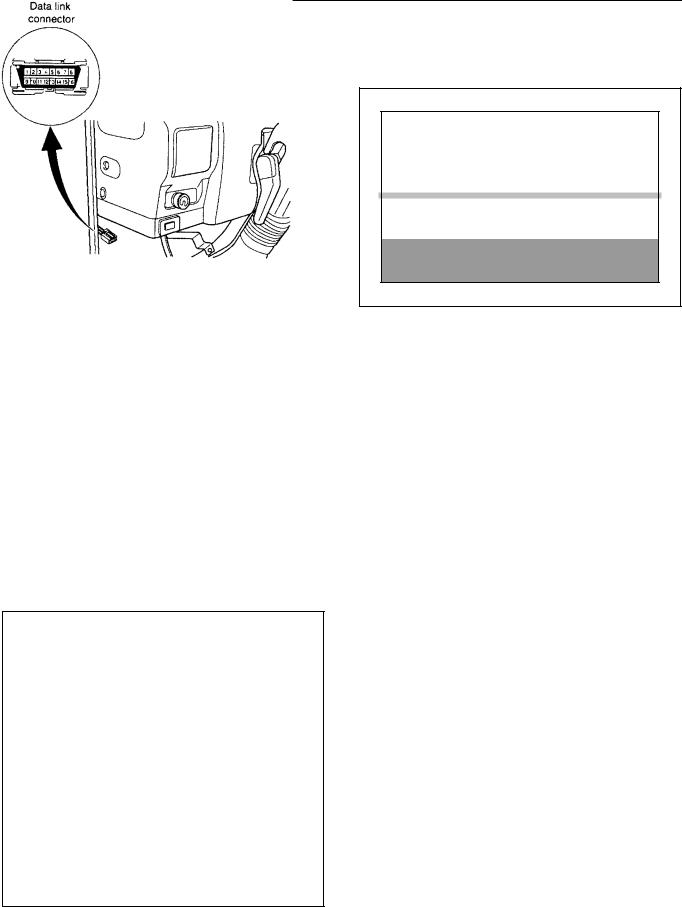
ANTI-LOCK BRAKE SYSTEM (ABS) 5A4-11
Tech 2 Features
1.Tech 2 is a 12 volt system. Do not apply 24 volt.
2.After connecting and/or installing the Vehicle Communications Interface (VCI) module, PCMCIA card and DLC connector to the Tech 2, connect the tool to the vehicle DLC.
3.Make sure the Tech 2 is powered OFF when removing or installing the PCMCIA card.
4.The PCMCIA card has a capacity of 10 Megabytes which is 10 times greater than the memory of the Tech 1 Mass Storage Cartridge.
5.The Tech 2 has the capability of two snapshots.
6.The PCMCIA card is sensitive to magnetism and static electricity, so care should be taken in the handling of the card.
7.The Tech 2 can plot a graph when replaying a snapshot.
8.Always return to the Main Menu by pressing the EXIT key several times before shutting down.
9.To clear Diagnostic Trouble Codes (DTCs), open Application Menu and press “F1: Clear DTC Info”.
Getting Started
•Before operating the Isuzu PCMCIA card with the Tech 2, the following steps must be performed:
1.The Isuzu 2000 Model Year System PCMCIA card
(1) inserts into the Tech 2 (5).
2.Connect the SAE 16/19 adapter (3) to the DLC cable (4).
3.Connect the DLC cable to the Tech 2 (5).
4.Make sure the vehicle ignition is off.
5.Connect the Tech 2 SAE 16/19 adapter to the vehicle DLC.
6.Turn on the vehicle ignition.
7.Power the Tech 2 ON and verify the Tech 2 power up display.
Tech2
Press [ENTER] to continue.
Software Version: X.XXX
NOTE: The RS232 Loop back connector is only to use for diagnosis of Tech 2. Refer to user guide of the Tech 2.
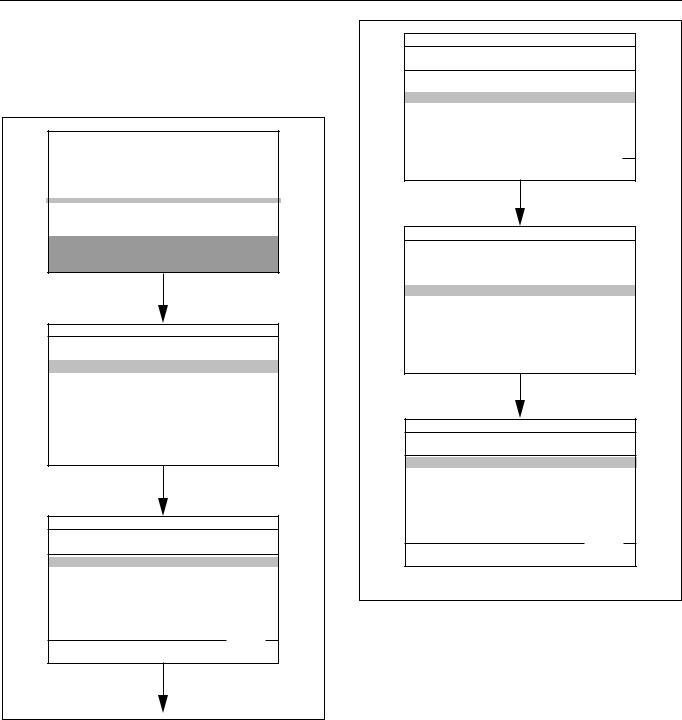
5A4-12 ANTI-LOCK BRAKE SYSTEM (ABS)
Operating Procedure (For Example)
The power up screen is displayed when you power up the tester with the Isuzu systems PCMCIA card. Follow the operating procedure below.
Tech2
Press [ENTER] to continue.
Software Version: X.XXX
(ENTER)
Main Menu
F0: Diagnostics
F1: Code Index
F2: View Capture Data
F3: Tool Options
F4: Download / Upload Help
(F0)
Vehicle Identification
Select one of the following
Model Year(s)
(1) 2001
(Y) 2000
(X) 1999
(W) 1998
1 / 4
(1) 2001
(2000, ENTER)
Vehicle Identification
Select one of the following
Vehicle Type (s)
(UE) Rodeo/Amigo, Wizard/MU
(TF ) LUV
(N ) ELF, NPR, NQR
(Off-Road) Industrial Engine
|
3 / 4 |
|
(N ) ELF, NPR, NQR |
||
|
(N ENTER)
System Selection Menu
(1) 2001 (N ) ELF, NPR, NQR
F0: Engine
F1: Chassis
F2: Body
(F2 ENTER)
Vehicle Identification
Select one of the following
Chassis
ABS
1 / 2
ABS
(ABS/ASR ENTER)

ANTI-LOCK BRAKE SYSTEM (ABS) 5A4-13
Menu
•The following table shows which functions are used for the available equipment versions.
Chassis
(Y)2000 (N ) ELF, NPR, NQR Electronic System: ABS
Partnumber |
8972521653 |
Identifier |
00(2WD) |
20(4WD)
40(ABS/ASR) 60(12V vehicle)
Partnumer
Confirm
DTC Modes
Chassis
F0: Diagnostic Trouble Codes
F1: Data Display
F2: Snapshot
F3: Actuator Test
There are two options available in Tech 2 DTC mode to display the enhanced information available. After selecting DTC, the following menu appears.
•DTC Info
•Clear Info
|
Diagnostic Trouble Codes |
|
|
F0: Read |
DTC Info Ordered By Priority |
F1: Clear |
DTC Information |
F2: DTC Information
F3: Clear & Reset Vehicle Type
The following is a brief description of each of the sub menus in DTC Info and DTC. The order in which they appear here is alphabetical and not necessarily the way they will appear on the Tech 2.
DTC Information Mode
Use the DTC info mode to search for a specific type of stored DTC information. There are two choices. The service manual may instruct the techinician to test for DTCs in a certain manner. Always follow published service procedures.
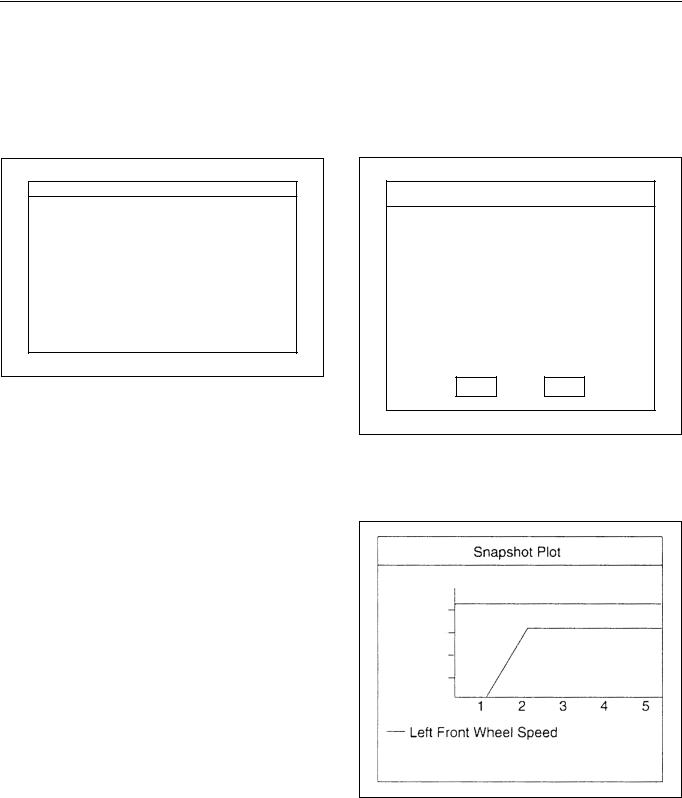
5A4-14 ANTI-LOCK BRAKE SYSTEM (ABS)
When CODE “13” is displayed (Vehicle Type Error)
Step |
Action |
Value(s) |
Yes |
No |
|
|
|
|
|
1 |
Check harness. |
- |
Erase vehicle |
Replace the |
|
Is it okay? |
|
type with TECH |
harness. |
|
|
|
2 and reread |
|
|
|
|
harness |
|
|
|
|
information. |
|
|
|
|
|
|
Diagnostic Trouble Codes
F0: Read DTC Info
F1: Clear DTC Info
F2: DTC Info
(F3: ENTER)
DTC Status
Current Diagnostic Trouble Codes
This selection will display all DTCs that have failed during the present ignition cycle.
History Diagnostic Trouble Codes
This selection will display only DTCs that are stored in the EHCU’s history memory.
Plotting Snapshot Graph
This test selects several necessary items from the data list to plot graphs and makes data comparison on a long term basis. This test can check ABS performance and defect by graphing wheel speed differences between right and left sides, and front and rear sides obtained from the ABS data list menu.
Clear & Reset Vehicle Type
Do you want clear &
Reset Vehicle Type?
YES NO
YES: Clear vehicle type and reread vehicle harness information.
NO: Return
For trouble diagnosis, you can collect graphic data (snap shot) directly from the vehicle.
You can replay the snapshot data as needed. Therefore, accurate diagnosis is possible, even though the vehicle is not available.
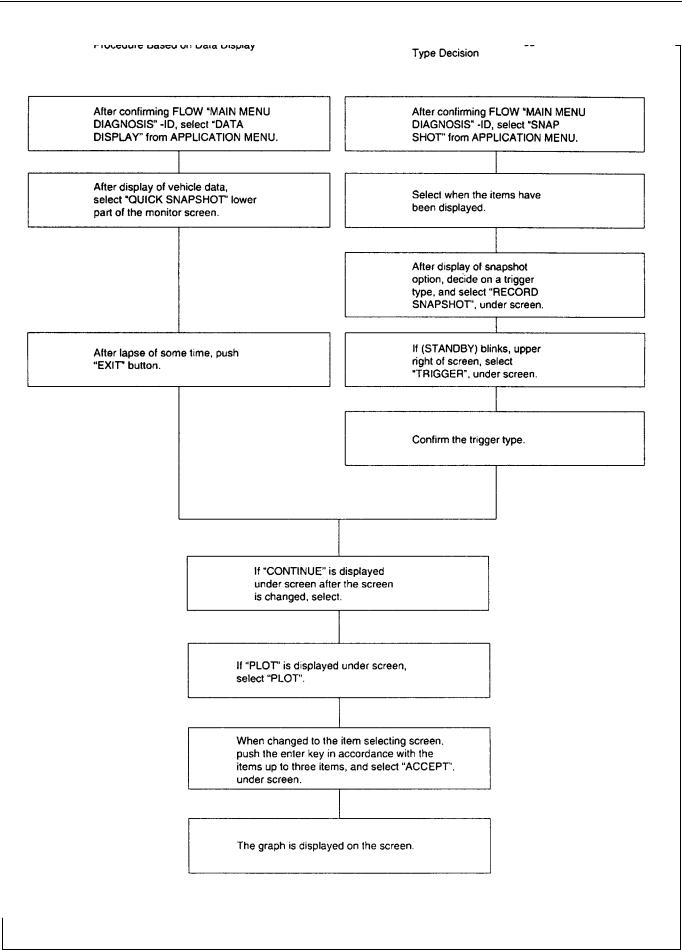
ANTI-LOCK BRAKE SYSTEM (ABS) 5A4-15
Plotting Graph Flow Chart (Plotting graph after obtaining vehicle information)

5A4-16 ANTI-LOCK BRAKE SYSTEM (ABS)
Flow Chart for Snapshot Replay (Plotting Graph)

ANTI-LOCK BRAKE SYSTEM (ABS) 5A4-17
Tech 2 Data Display
Use the Tech 2 data Values only after the ABS Diagnostic System Check has been completed, no DTC(s) were noted, and you have determined that the on-board diagnostics are functioning properly. Tech 2 values from a properly-running engine may be used for comparison with the engine you are diagnosing.
ABS Data
Ignition SW is “ON” position.
(For example)
Special Function
There are 12 different menus available for this test. The state of each circuit can be tested by using these menus. Especially when DTC cannot be detected, a faulty circuit can be diagnosed by testing each circuit by means of these menus.
Even when DTC has been detected, the circuit tests using these menus could help discriminate between a mechanical trouble and an electrical trouble.
In all cases test condition; Engine stops with the key turned to the “ON” position. To be more specific, the test is conducted with the brake pedal stepped on after stepping once and releasing.
•Engine: Stop
•Ignition SW: ON
•Brake Pedal: ON-OFF-ON
If the Ignition SW was turned OFF or communication was lost, make sure to apply the brake pedal ON-OFF- ON once again and then continue the test.
Actuator Test
F0: ABS Relay Test
F1: Return Pump Relay Test
F2: Front Left Solenoid Valve Test
F3: Front Right Solenoid Valve Test
F4: Rear Left Solenoid Valve Test
F5: Rear Right Solenoid Valve Test
F6: ABS Check Light Test
F7: Exhaust Brake Cut Test

ABS Motor
Test condition: Engine stops with the key turned to the “ON” position. To be more specific, the test is conducted with the brake pedal stepped on after stepping once and releasing.
Make sure of the working sound of the ABS motor. The circuit is normal if the working sound of the ABS motor is made in accordance with Tech 2’s instruction.
Actuator Test
F0: ABS Relay Test
F2: Front Left Solenoid Valve Test
F3: Front Right Solenoid Valve Test
F4: Rear Left Solenoid Valve Test
F5: Rear Right Solenoid Valve Test
F6: ABS Check Light Test
F7: Exhaust Brake Cut Test
Exhaust Brake Cut Relay
Test condition: Engine stops with the key turned to the “ON” position. To be more specific, the test is conducted with the brake pedal stepped on after stepping once and releasing.
Make sure of the working sound of the exhaust brake cut relay.
The circuit is normal if the working sound of the exhaust brake cut relay is made in accordance with Tech 2’s instruction.
Actuator Test
F0: ABS Relay Test
F1: Return Pump Relay Test
F2: Front Left Solenoid Valve Test
F3: Front Right Solenoid Valve Test
F4: Rear Left Solenoid Valve Test
F5: Rear Right Solenoid Valve Test
F6: ABS Check Light Test
|
ANTI-LOCK BRAKE SYSTEM (ABS) 5A4-19 |
Hold Valve Test |
Select a Iso Solenoid |
Purpose: The purpose of this test is to detect brake |
from the Front Left Solenoid Valve Test |
pipe and valve line harness wire wrong connections |
Function Menus. |
and valve trouble. |
|
|
|
|
|
|||
This test will help you confirm the result of your repair |
|
|
|
|
|
|||
service including the removal/reinstallation of brake |
|
|
Front Left Solenoid Valve Test |
|
|
|||
pipe, valve line harness and valve. |
|
|
|
|
|
|||
|
|
|
|
|
|
|
|
|
|
|
|
|
|
|
|
|
|
|
Actuator Test |
|
|
|
|
|
|
|
|
|
|
|
|
Dump Solenoid |
|
|
|
|
F0: ABS Relay Test |
|
|
|
|
|
|
|
|
F1: Return Pump Relay Test |
|
|
|
|
|
|
|
|
F3: Front Right Solenoid Valve Test |
|
|
|
|
|
|
|
|
F4: Rear Left Solenoid Valve Test |
|
|
|
|
|
|
|
|
F5: Rear Right Solenoid Valve Test |
|
|
|
|
|
|
|
|
F6: ABS Check Light Test |
|
|
|
|
|
|
|
|
|
|
|
|
|
|
||
|
F7: Exhaust Brake Cut Test |
|
|
|
|
|
|
|
|
|
|
3. |
Press the Hold Valve “ON” Soft Key with the brake |
||||
|
|
|
|
|
pedal stepped on. |
|||
|
|
|
4. |
Release the brake pedal. |
||||
|
|
|
||||||
|
|
|
5. |
Make sure that the Hold Valve “ON” aimed at by |
||||
|
|
|
||||||
Test conditions: The ignition key is the “ON” position |
|
|
Tech 2 and the wheel locked position are the |
|||||
with the four wheels lifted up. The brake pedal is |
|
|
same. If different, check brake pipe, valve line |
|||||
stepped on, released and stepped on again with the |
|
|
harness wiring and H/UNIT. Repair is needed if |
|||||
parking brake released. |
|
|
abnormality is found. |
|||||
|
|
|
6. |
Conduct Step 2 through Step 5 above on all the |
||||
Test procedure: |
|
|
four wheels. |
|||||
1. Connect Tech 2 with the vehicle, and select |
CAUTION: When conducting this test, please |
|||||||
|
Special Function from the menus. |
|||||||
2. Select a Hold Valve Menu from the Special |
observe the following cautions. |
|||||||
1. |
Do not start the engine without fail. |
|||||||
|
Function Menus. |
|||||||
|
|
|
2. |
Lift up the vehicle at the level floor. |
||||
|
|
|
|
|
• Secure a clearance from the floor surface |
|||
|
|
|
|
|
||||
|
|
|
|
|
enough to allow the lifted tire to rotate. |
|||
|
Actuator Test |
|
|
|
||||
|
|
3. |
Maintain the lift up. |
|||||
|
|
|
||||||
|
F0: ABS Relay Test |
|
4. |
Wipe the floor surface to remove water and oil |
||||
|
|
|
|
so that the surface may become unslippery. |
||||
|
F1: Return Pump Relay Test |
|
|
|
||||
|
|
5. |
Do not load the vehicle. |
|||||
|
F3: Front Right Solenoid Valve Test |
|
||||||
|
|
|
|
• When lifting up the vehicle, be sure to |
||||
|
F4: Rear Left Solenoid Valve Test |
|
|
|
observe the lifting up points. Refer to |
|||
|
F5: Rear Right Solenoid Valve Test |
|
|
|
||||
|
|
|
|
vehicle lifting points in 0A section. |
||||
|
F6: ABS Check Light Test |
|
|
|
||||
|
F7: Exhaust Brake Cut Test |
|
|
|
|
|
|
|
|
|
|
|
|
|
|
|
|
|
|
|
|
|
|
|
|
|

5A4-20 ANTI-LOCK BRAKE SYSTEM (ABS)
Release Valve Test
Purpose: The purpose of this test is to detect brake pipe and valve line harness wire wrong connections and valve trouble.
This test will help you confirm the result of your repair service including the removal/reinstallation of brake pipe, valve line harness and valve.
Actuator Test
F0: ABS Relay Test
F1: Return Pump Relay Test
F3: Front Right Solenoid Valve Test
F4: Rear Left Solenoid Valve Test
F5: Rear Right Solenoid Valve Test
F6: ABS Check Light Test
F7: Exhaust Brake Cut Test
Test conditions: The ignition key is in the “ON” position with the four wheels lifted up. The brake pedal is stepped on, released and stepped on again with the parking brake released.
Test procedure:
1.Connect Tech 2 with the vehicle, and select Special Function from the menus.
2.Select a Release Valve Menu from the Special Function Menus.
Actuator Test
F0: ABS Relay Test
F1: Return Pump Relay Test
F3: Front Right Solenoid Valve Test
F4: Rear Left Solenoid Valve Test
F5: Rear Right Solenoid Valve Test
F6: ABS Check Light Test
F7: Exhaust Brake Cut Test
Select a Dump Solenoid
from the Front Left Solenoid Valve Test Function Menus.
Front Left Solenoid Valve Test
Iso Solenoid
3.Press the Release Valve “ON” Soft Key with the brake pedal stepped on.
4.Make sure that the Release Valve “ON” aimed at by Tech 2 and the wheel released position are the same. If different, check brake pipe, valve line harness wiring and H/UNIT. Repair is needed if abnormality is found.
5.Conduct Step 2 through Step 5 above on all the four wheels.
CAUTION: When conducting this test, please observe the following cautions.
1.Do not start the engine without fail.
2.Lift up the vehicle at the level floor.
•Secure a clearance from the floor surface enough to allow the lifted tire to rotate.
3.Maintain the lift up.
4.Wipe the floor surface to remove water and oil so that the surface may become unslippery.
5.Do not load the vehicle.
•When lifting up the vehicle, be sure to observe the lifting up points. Refer to vehicle lifting points in 0A section.
